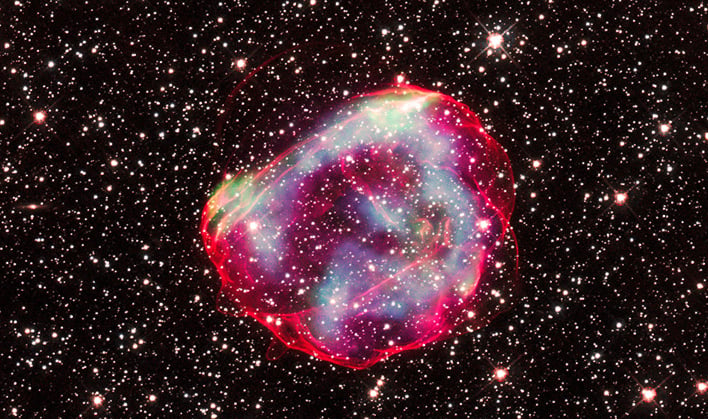How NASA's Stunning Supernova Photo Might Help Predict When A Star Is On Death's Doorstep

It is believed that the dwarf star in question reached a critical mass, "either by pulling matter from a companion star or merging with another white dwarf star," according to a post on the Chandra X-ray Observatory website. The resulting supernova is known as a Type Ia, and is often used for studying thermonuclear explosions, as well as measuring distances to galaxies billions of light years away.
The spectacular image of SNR 0519 was captured using X-ray data collected from NASA's Chandra X-ray Observatory, and optical data from NASA's Hubble Space Telescope. In the image below, the green represents X-ray at low energy, blue indicates X-ray at medium energy, and the purple highlights X-ray at high energy.
The data from Chandra and Hubble was also combined with data from NASA's retired Spitzer Space telescope in order to determine how long ago the star in SNR 0519 exploded. It also helped to determine more about the environment the supernova occurred in. All of the combined data allowed astronomers to "rewind the movie of the stellar evolution that has played out since," and ultimately when it got its start.
Part of the discovery process included comparing Hubble images from 2010, 2011, and 2020. This enabled those researching to measure the speeds of the material in the blast wave from the explosion. Those speeds range anywhere from about 3.8 million to 5.5 million miles (9 million kilometers) per hour. This helped the team determine that the light from the explosion should have reached Earth some 670 years ago, or more specifically during the Hundred Years' War between England and France.
However, it is more likely that the material has actually slowed down, and the explosion actually happened more recently, according to the authors of the paper recently published in the August issue of The Astrophysical Journal. Data from Chandra and Spitzer give clues that this in fact the case. That data indicates that the brightest regions in X-ray are the slowest moving material, and there is no X-ray emission associated with the fastest moving material.
The result is thought to be the blast wave has hit a wall of sorts, or into dense gas around the remnant, causing the apparent slow down. Astronomers plan on trying to determine more precisely when the time of the star's destruction occurred using observations from Hubble in the future.


